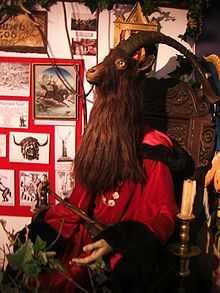Museum of Witchcraft
Coordinates: 50°41′20″N 4°41′31″W / 50.689°N 4.692°W

Museum of Witchcraft in Boscastle, Cornwall, England, is a museum dedicated to witchcraft. It has the largest collection of witchcraft and Wiccan related artefacts in the world. It opened on the Isle of Man in 1951, moving to its current location in 1960.
The museum holds a large number of artefacts, much of which once belonged to the museum's founder Cecil Williamson, including human remains, and currently also holds the Richell collection of witchcraft regalia that was loaned to the museum in 2000 from the Netherlands.
History

Neopagan Witch Cecil Williamson tried to open a museum to hold his collection of witchcraft and occult artefacts in Stratford-upon-Avon in 1947, but faced local opposition and had to abandon his plans.[1]
In 1951, Williamson opened the museum, under the name of the Folklore Center of Superstition and Witchcraft at Castletown on the Isle of Man. He had it set up in a dilapidated old mill known locally as the Witches' Mill which he had purchased in 1948, and, at the advice of his wife, opened an adjacent restaurant, known as the Witches' Kitchen.
Williamson employed Gerald Gardner, to work at the museum as the director and 'resident witch'. Gardner fell out with Williamson over what he saw as sensationalist displays. Williamson, in retaliation, removed a photograph of Gardner from the display.
Williamson decided to return to England, and took his collection of witchcraft artefacts with him. In 1954 Gardner bought the Witches' Mill from him, and renamed it The Museum of Magic and Witchcraft, filling it with his own collection of artefacts. During the 1950s, Gardner discussed moving his museum to London with his then friend, Charles Cardell, but decided not to.[2] Gardner continued to run the museum till his death in 1964, when it was briefly run by his High Priestess Monique Wilson before it was shut down and the collection sold off. Ripley's Entertainment Inc. bought the collection and in 1972 opened the "Museum of Witchcraft and Magic" at Gatlinburg, Tennessee and San Francisco, California. In 1975, due to pressure from the local church and religious groups, Ripley's changed the name of the museums to the "World of the Unexplained". More attractions and items were added to the present witchcraft collection. In 1985, Ripley's closed both museums due to poor ticket sales. The collection was disbursed to other Ripley's museums. A lot of the witchcraft collection was sent to Ripley's Believe It or Not museum at Blackpool.
On his return to England in 1954, Williamson opened the museum, now known as the Museum of Witchcraft, to Windsor. Here it stayed open for the tourist season, and was quite successful, but local opinion was still against it, and so Williamson decided to move it again.
In 1954 Williamson moved the museum to Bourton-on-the-Water in Gloucestershire.
In 1960 Williamson moved the museum to Boscastle in Cornwall. Williamson sold it at midnight on Samhain 1996, and died in 1999. The new owner, Graham King has since appeared on BBC TV series such as A Seaside Parish and Antiques Roadshow. He organised the burial of Joan Wytte, a woman who died in Bodmin Jail under accusations of witchcraft in 1813, and whose corpse had been at the museum for many years. She was buried in a local area of woodland in 1998.[3] The museum was damaged during heavy floods in 2004.[3]
In 2011, The Occult Art Company published an anthology entitled The Museum of Witchcraft: A Magical History, edited by Kerrian Godwin. The anthology was reviewed in peer-reviewed academic journal The Pomegranate: The International Journal of Pagan Studies by Pagan studies scholar Ethan Doyle White. He noted that it contained "a wonderful collection of accounts" from occultists that recounted the spiritual experiences that they had had with the museum and its collections, but that some of these were "a little repetitive". Ultimately, he thought that the work could be described as a "mixed bag, with the articles varying in their quality and relevance to the subject at hand." He remained critical that despite the work's subtitle, it made very little reference to the museum's history, and that it was overly praiseworthy, not allowing for any criticism of the museum.[4]
Exhibits

There are various rooms displaying different exhibits. There are sections devoted to the Wiccan wheel of the year, Horned God, Mother Goddess, divination, stone circles, village white witch and cunning folk, protective charms, and mandrakes. There is also a small section on Satanism that explains that it is different from Wicca, and it contains a medallion given to the museum by the Church of Satan.
The Museum also has a large library of books, including a scrapbook belonging to Doreen Valiente.
See also
References
Footnotes
Bibliography
- Doyle White, Ethan (2011). "Review of The Museum of Witchcraft: A Magical History". The Pomegranate: The International Journal of Pagan Studies. 13(1) (London: Equinox Publishing). pp. 106–108.
External links
| Wikimedia Commons has media related to Museum of Witchcraft. |
| |||||||||||||||||||||||||||||||||||||
| ||||||||||||||||||||
